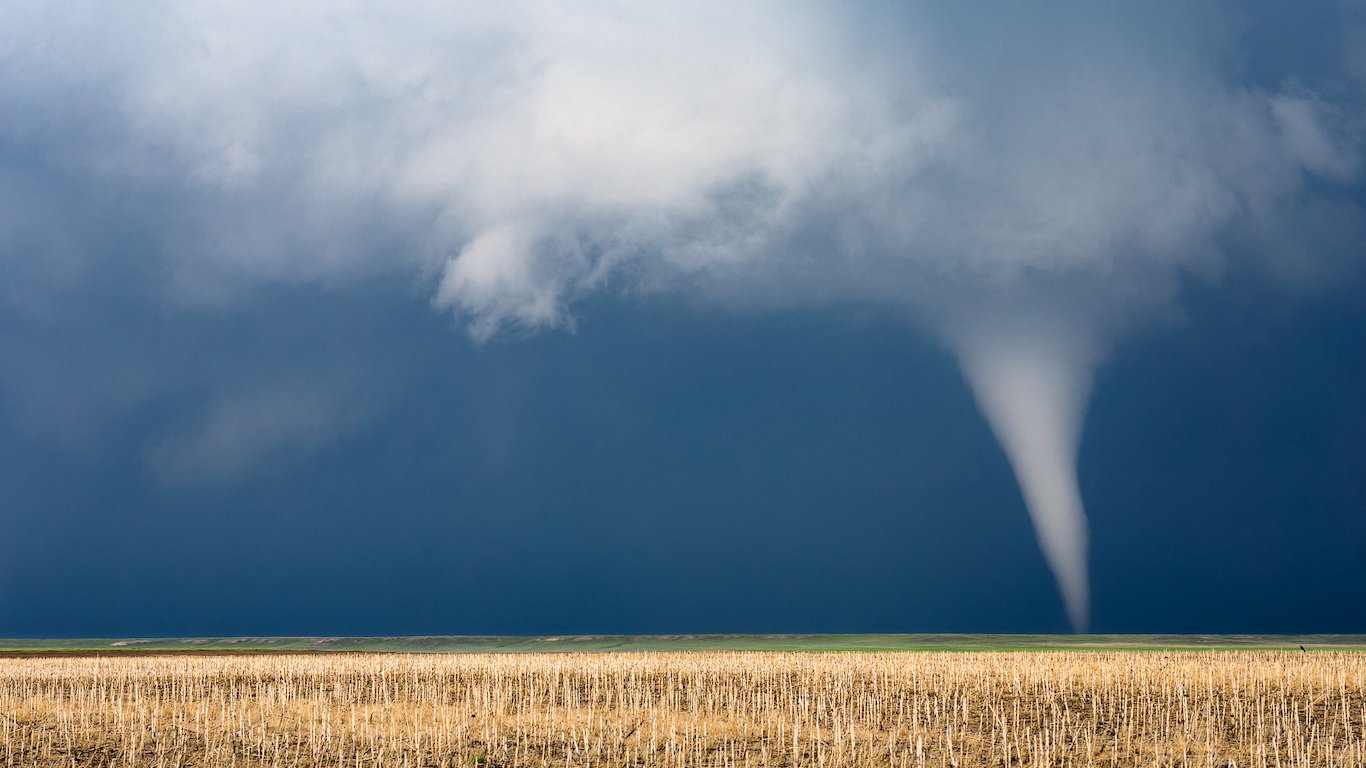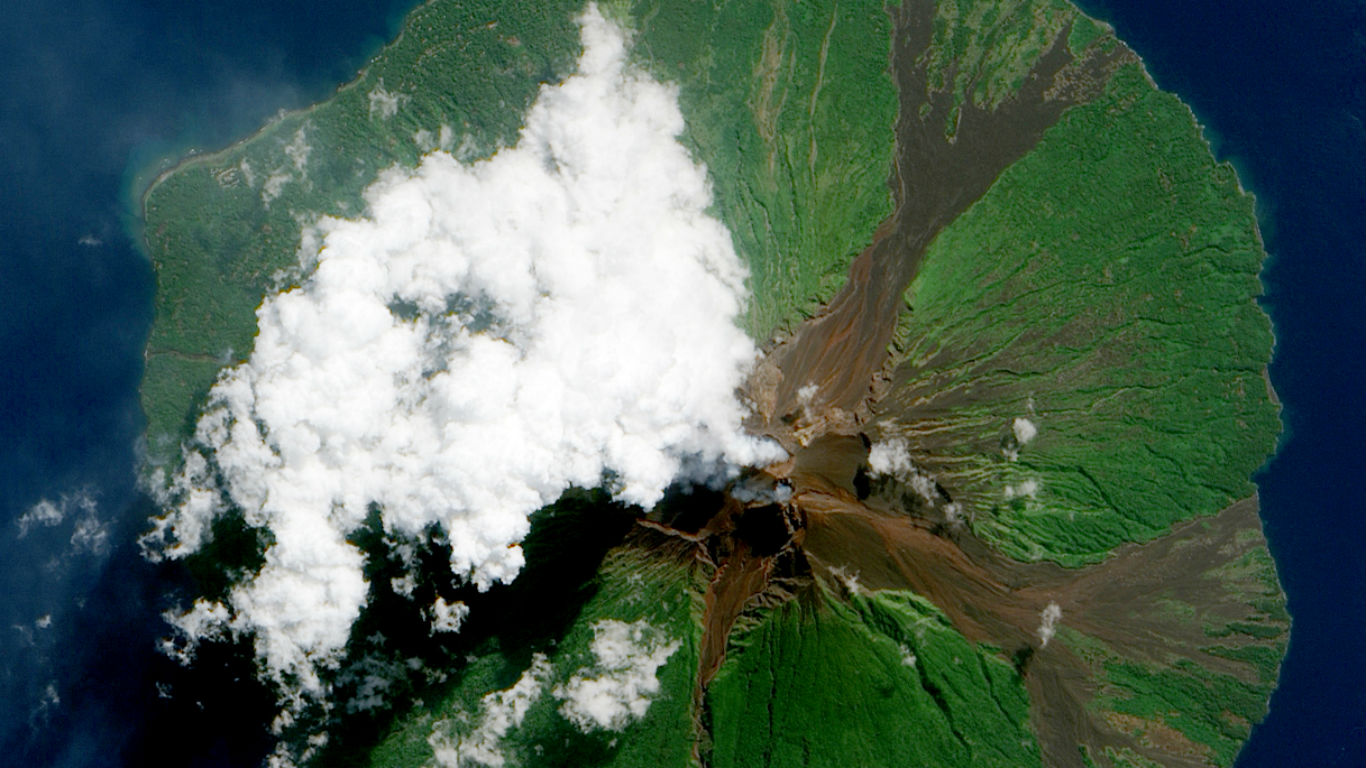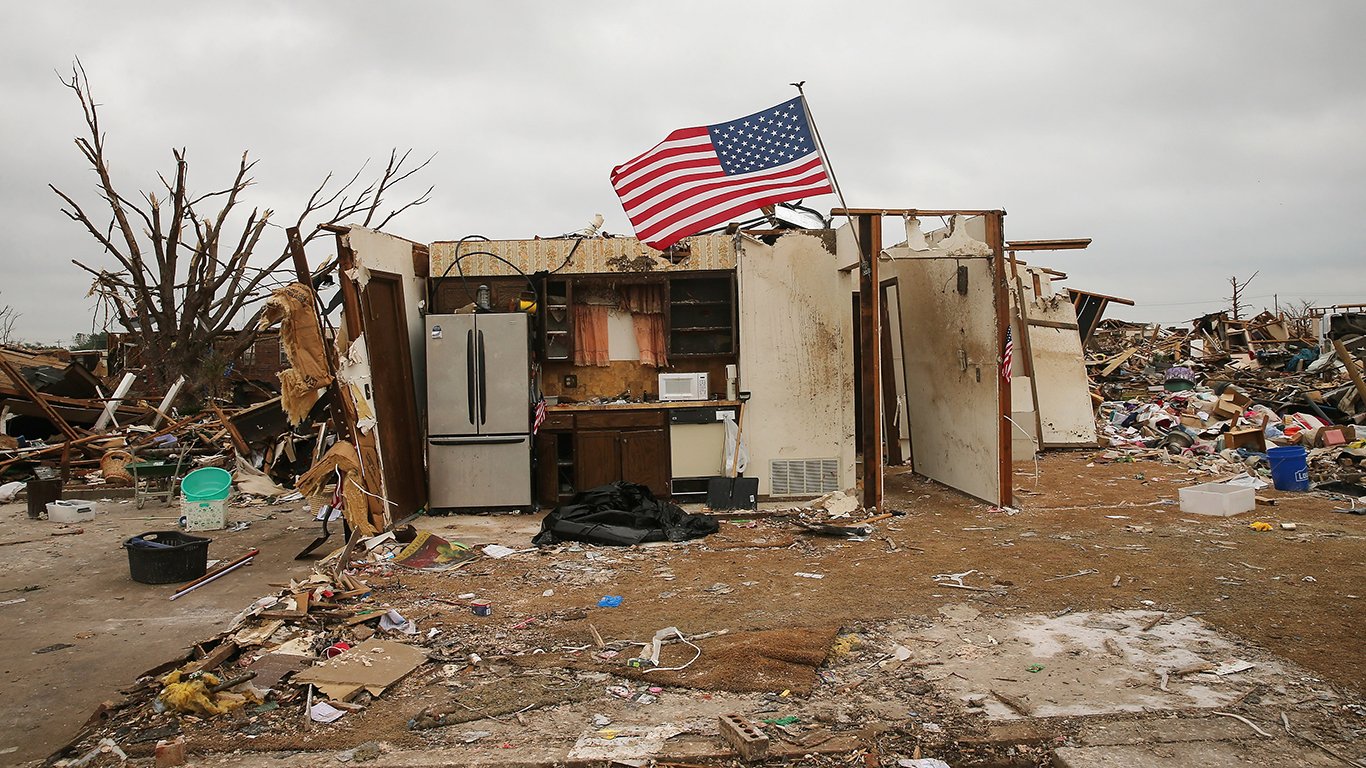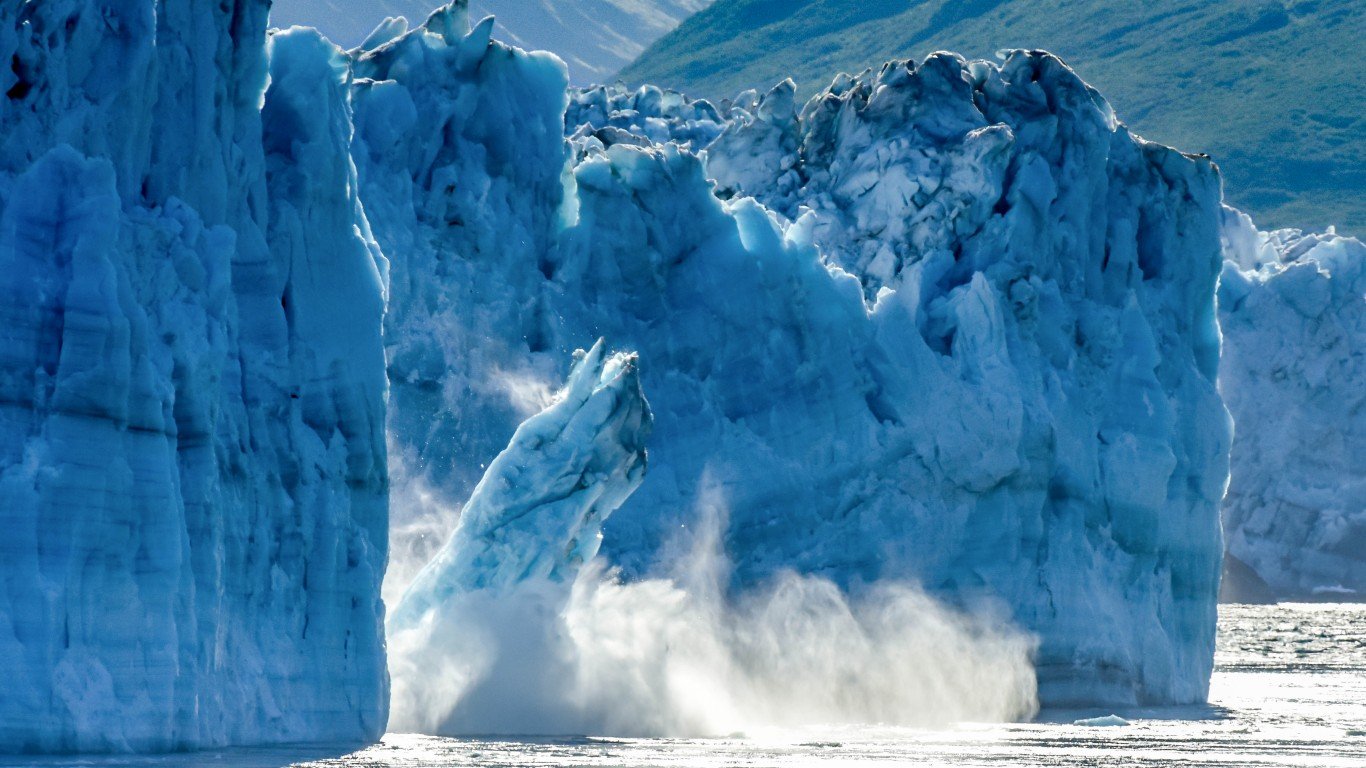

By 2040, the global average surface air temperature will be 1.5 degrees Celsius (2.7 F) higher compared to pre-industrial (latter half of the 19th century) levels, according to the most recent projections from the Intergovernmental Panel on Climate Change. The IPCC projections under the high emissions scenario also predict that by 2100 parts of the planet could become too hot for humans. (Earth’s CO2 level rose every year since climate change became a national issue.)
With the Earth getting warmer and wetter thanks to human industrial, agricultural, and personal activities, it is causing deadly floods, droughts, heatwaves, erratic weather patterns, and stronger, more frequent storms across the globe. But climate change has been affecting countries to different degrees.
To identify the 25 counties least vulnerable to climate change, 24/7 Wall St. reviewed the Notre Dame Global Adaptation Initiative that measures the vulnerability to climate change and readiness of 182 different countries. Countries are ranked by their overall index score, which itself consists of a vulnerability index and a readiness index.
The vulnerability index “measures a country’s exposure, sensitivity and capacity to adapt to the negative effects of climate change,” considering indicators in six life-supporting sectors: food, water, health, ecosystem service, human habitat, and infrastructure. The readiness index “measures a country’s ability to leverage investments and convert them to adaptation actions” and considers different indicators in three components: economic readiness, governance readiness, and social readiness.
We also added GDP per capita and total population from the World Bank World Development Indicators for 2020.
About 944 million live in the 25 countries that are most vulnerable to climate crises (23 of them in Africa), most of them in extreme poverty. About the same number of people, about 906 million, live in the 25 mostly high-income countries on this list – the ones least vulnerable to climate crises.
Most of the 906 million people least vulnerable to climate change live in European countries, the United States, and Canada. About 215 million of these lucky global residents live in the Asia-Pacific region: in Japan, South Korea, Australia, New Zealand, and Singapore. (These are the worst cities to live as climate change gets worse.)
While similar threats face high-income and low-income countries, the outcomes are radically different. High-income countries with stable political systems have more resources to handle climate emergencies and disasters. They are also better able to prepare and even stave off some of the effects with investment in infrastructure, agriculture, health, and more.
This imbalance between poorer and wealthier nations in their vulnerability and readiness for climate change is even more disturbing when considering that poorer nations emit far less carbon emissions than rich nations. (These are the 20 countries responsible for nearly all global emissions.)
Here are the least vulnerable countries most prepared for the climate crisis.

25. Portugal
> Overall index score: 62.2
> Vulnerability score: 0.34
> Best dimension: Ecosystem Services
> Readiness score: 0.58
> Best readiness dimension: Governance
> GDP per capita: $31,962 – #38 highest out of 182 countries
> Population: 10,297,081 – #87 highest out of 182 countries
“Portugal is one of the countries most affected by climate change,” EU President Ursula von der Leyen said during a 2019 European Council meeting, a statement that is more accurate if you compare Portugal with other developed high-income nations. Nevertheless, the Iberian coastal country is experiencing more extreme weather events, notably more intense heatwaves and droughts as well as flooding and wildfires.
[in-text-ad]

24. Czech Republic
> Overall index score: 62.6
> Vulnerability score: 0.30
> Best dimension: Human Habitat
> Readiness score: 0.56
> Best readiness dimension: Governance
> GDP per capita: $38,511 – #32 highest out of 182 countries
> Population: 10,697,858 – #85 highest out of 182 countries
According to the International Energy Agency, average temperatures in the Czech Republic have been rising at a faster pace than the global average, with temperatures rising the fastest during the summer months. The country’s agricultural and forestry industries are threatened by rising temperatures, falling precipitation, and an increase in the frequency of extreme weather events.

23. Belgium
> Overall index score: 62.7
> Vulnerability score: 0.35
> Best dimension: Infrastructure
> Readiness score: 0.60
> Best readiness dimension: Governance
> GDP per capita: $48,753 – #16 highest out of 182 countries
> Population: 11,544,241 – #80 highest out of 182 countries
As elsewhere, average temperatures in Belgium have been rising and precipitation patterns have been changing. Belgium winters are wetter and there are more extreme precipitation events, usually in the winter. In the summer of 2021, the eastern part of this small European country, as well as parts of neighboring Germany and The Netherlands, were struck with severe flooding that killed dozens.
22. Estonia
> Overall index score: 62.8
> Vulnerability score: 0.36
> Best dimension: Human Habitat
> Readiness score: 0.62
> Best readiness dimension: Governance
> GDP per capita: $35,257 – #36 highest out of 182 countries
> Population: 1,329,479 – #149 highest out of 182 countries
The northernmost country of the Baltic states, south of Finland, is susceptible to the effects of melting glaciers, ice caps, and ice sheets due to its extensive coastline and low coastal areas. To get an idea of how exposed Estonia is to flooding: the country has long been known for its “fifth season,” a tourist attraction in March and April, when rainfall makes swaths of lower forests, meadows, and populated areas, navigable only by water. Estonian officials have identified 20 areas at high risk of flooding.
[in-text-ad-2]

21. Ireland
> Overall index score: 64.0
> Vulnerability score: 0.32
> Best dimension: Exposure
> Readiness score: 0.60
> Best readiness dimension: Governance
> GDP per capita: $90,789 – #3 highest out of 182 countries
> Population: 4,985,674 – #121 highest out of 182 countries
Projections indicate that changes in storm trajectories and wind speeds due to global warming will increase the likelihood of flooding along Irish riverbanks and coastlines. The heaviest rainfall strikes the western part of the country especially at higher altitudes. In December, Storm Barra, a hurricane-force northern cyclone, inundated communities in Ireland the United Kingdom

20. Slovenia
> Overall index score: 64.1
> Vulnerability score: 0.32
> Best dimension: Human Habitat
> Readiness score: 0.60
> Best readiness dimension: Governance
> GDP per capita: $37,051 – #34 highest out of 182 countries
> Population: 2,102,419 – #142 highest out of 182 countries
Slovenia’s diverse climate profile means the country is vulnerable to different kinds of extreme weather events in different areas, namely from heat waves, forest fires, and drought conditions, as well as flooding during rainier parts of the year. This summer, Slovenia was struck with its largest forest fire on record near its border with Italy. The fire burned through 3,600 hectares (about 14 square miles) of land.
[in-text-ad]

19. Japan
> Overall index score: 65.5
> Vulnerability score: 0.38
> Best dimension: Human Habitat
> Readiness score: 0.69
> Best readiness dimension: Governance
> GDP per capita: $39,935 – #28 highest out of 182 countries
> Population: 126,261,000 – #11 highest out of 182 countries
Japan and South Korea are the only two east Asian countries to make this list. But Japan is highly susceptible to major storms, like the 2019 Typhoon Hagibis that heavily damaged parts of centrally located Nagano District. Heat waves across the country in 2018 and 2019 hospitalized thousands while millions evacuated homes amid record rainfall in the same time, a reminder that even highly developed and wealthy countries are vulnerable to climate change.

18. United States
> Overall index score: 66.2
> Vulnerability score: 0.33
> Best dimension: Exposure
> Readiness score: 0.65
> Best readiness dimension: Governance
> GDP per capita: $59,755 – #9 highest out of 182 countries
> Population: 331,501,080 – #3 highest out of 182 countries
The United States, a country responsible for the largest share of historical CO2 emissions and the second-highest emitter of the potent greenhouse gas today, is among the countries least vulnerable to the effects of global warming. However, extreme weather events, brutal droughts and heat waves, massive wildfires, and flooding, are expected to increase in frequency and impact.

17. Netherlands
> Overall index score: 66.6
> Vulnerability score: 0.35
> Best dimension: Infrastructure
> Readiness score: 0.68
> Best readiness dimension: Governance
> GDP per capita: $54,324 – #11 highest out of 182 countries
> Population: 17,441,500 – #67 highest out of 182 countries
The Netherlands is well-regarded for its ability to keep the North Sea at bay from flooding the 26% of the country that’s below sea level. It will need to amplify its water management efforts in the years to come as sea levels rise and storm surges intensify. More than half of the Netherlands is considered a flood risk. Rising temperature will pose additional challenges for the country’s important agricultural sector that exports both commodities like cereals and potatoes and specialty crops like produce and flower bulbs.
[in-text-ad-2]

16. France
> Overall index score: 66.9
> Vulnerability score: 0.31
> Best dimension: Human Habitat
> Readiness score: 0.65
> Best readiness dimension: Governance
> GDP per capita: $42,321 – #24 highest out of 182 countries
> Population: 67,379,908 – #21 highest out of 182 countries
The climate of France is mostly temperate, with higher Alpine regions to the east and mild Mediterranean weather in its coastal south. Historical records show an increase in rainfall in the autumn and winter, and less rain in the summer months. Like other countries in the region, France is experiencing temperature changes that are trending toward more summer heat waves and warmer winters. France was struck with two major heat waves this past summer.

15. Korea, Rep.
> Overall index score: 67.2
> Vulnerability score: 0.38
> Best dimension: Ecosystem Services
> Readiness score: 0.73
> Best readiness dimension: Social Readiness
> GDP per capita: $42,336 – #23 highest out of 182 countries
> Population: 51,836,239 – #28 highest out of 182 countries
In August, Seoul was stuck with the heaviest rainfall in 115 years. The rainfall caused blackouts and landslides, inundated roads and subway systems, and killed several people in the northern part of the country. Following the extreme weather event, government officials implemented a $1.15 billion, 10-year plan to build six huge underground tunnels to capture rainfall during heavy deluges and release it after the rains subside.
[in-text-ad]

14. Canada
> Overall index score: 67.5
> Vulnerability score: 0.30
> Best dimension: Human Habitat
> Readiness score: 0.65
> Best readiness dimension: Governance
> GDP per capita: $46,064 – #19 highest out of 182 countries
> Population: 38,037,204 – #38 highest out of 182 countries
“Canada’s climate is already changing,” declares the Government of Canada’s website. Extreme weather events and rising sea levels are expected to hit Canada hard due to its 115,600 miles of coastline, the longest of any country in the world. But flooding isn’t the only major global warming threat to Canada. Like the western United States, western Canada is susceptible to an increase in the frequency of wildfires attributed to rising temperatures and drier conditions.

13. Australia
> Overall index score: 68.5
> Vulnerability score: 0.32
> Best dimension: Human Habitat
> Readiness score: 0.69
> Best readiness dimension: Governance
> GDP per capita: $48,679 – #17 highest out of 182 countries
> Population: 25,693,267 – #55 highest out of 182 countries
Australia, the world’s largest exporter of black coal, iron ore, alumina, lead, and zinc, important ingredients in global industrial activity, is susceptible to the effects of global warming. Climate change is bringing greater risk of floods, droughts, wildfires, and drier weather during the winter and spring to the heavily-populated southern and eastern parts of Australia.

12. Luxembourg
> Overall index score: 68.6
> Vulnerability score: 0.30
> Best dimension: Human Habitat
> Readiness score: 0.67
> Best readiness dimension: Governance
> GDP per capita: $112,557 – #1 highest out of 182 countries
> Population: 630,419 – #159 highest out of 182 countries
Like its neighbors, this tiny, affluent, landlocked European country is expected to experience an increase in heavy precipitation events, especially during the winter months, along with higher summertime temperatures that will tax the country’s electrical grid.
[in-text-ad-2]

11. United Kingdom
> Overall index score: 69.4
> Vulnerability score: 0.30
> Best dimension: Human Habitat
> Readiness score: 0.68
> Best readiness dimension: Governance
> GDP per capita: $42,821 – #22 highest out of 182 countries
> Population: 67,081,000 – #22 highest out of 182 countries
The warming of the Atlantic Gulf Stream, a vital current that delivers warmer waters (which are becoming increasingly warmer) from the Caribbean Sea into the North Atlantic, will continue to impact weather patterns in the United Kingdom, Ireland, and other European countries most affected by this current. Like Continental Europe, the U.K. is expected to experience hotter summers and milder, wetter winters, marked with more cold-weather flooding like the one caused by Storm Barra that slammed into Ireland and the U.K. in December.

10. New Zealand
> Overall index score: 69.7
> Vulnerability score: 0.31
> Best dimension: Human Habitat
> Readiness score: 0.70
> Best readiness dimension: Governance
> GDP per capita: $41,642 – #25 highest out of 182 countries
> Population: 5,090,200 – #119 highest out of 182 countries
Most of New Zealand is projected to receive greater amounts of rainfall and more extreme precipitation events, including more tropical cyclones, due to global warming. These deluges will increase soil erosion and the frequency of landslides. At the same time, drought conditions are expected to increase in parts of North Island and the Southern Alps. Hotter summertime temperatures will increase risks from seasonal wildfires and heatwaves.
[in-text-ad]

8. Germany
> Overall index score: 69.8
> Vulnerability score: 0.29
> Best dimension: Water
> Readiness score: 0.69
> Best readiness dimension: Governance
> GDP per capita: $51,423 – #14 highest out of 182 countries
> Population: 83,160,871 – #19 highest out of 182 countries
Changes to the climate will increase temperature extremes in Germany, causing more frequent and potentially fatal heat waves and droughts. Last year, the government identified about 30 climate change impacts requiring urgent action, including deadly heat stress, agricultural water shortages, and flash flooding caused by intermittent extreme precipitation events during the winter months.

8. Iceland
> Overall index score: 69.8
> Vulnerability score: 0.32
> Best dimension: Human Habitat
> Readiness score: 0.72
> Best readiness dimension: Governance
> GDP per capita: $52,376 – #12 highest out of 182 countries
> Population: 366,463 – #168 highest out of 182 countries
As a tiny, sparsely-populated high-income country, Iceland is one of the countries laest vulnerable to climate change. However, most of its population of about 350,000 reside on the coastline in and around the capital of ReykjavÃk, making these people susceptible to the effects of rising sea levels. Rapid ocean acidification occurring in waters around the island will harm the key fishing and seafood industries.

7. Austria
> Overall index score: 70.1
> Vulnerability score: 0.28
> Best dimension: Exposure
> Readiness score: 0.69
> Best readiness dimension: Governance
> GDP per capita: $51,858 – #13 highest out of 182 countries
> Population: 8,916,864 – #97 highest out of 182 countries
Austria is particularly at risk from flooding and landslides due to its topography and its high number of rivers and streams, and the country has been struck by several extreme flooding events since the start of the century. Winter precipitation in the northeast is projected to increase by 30%. As a high-income country with strong governance, Austria is one of most equipped to confront the climate-change challenges that lay ahead.
[in-text-ad-2]

6. Singapore
> Overall index score: 70.6
> Vulnerability score: 0.39
> Best dimension: Exposure
> Readiness score: 0.80
> Best readiness dimension: Governance
> GDP per capita: $94,506 – #2 highest out of 182 countries
> Population: 5,685,807 – #112 highest out of 182 countries
This wealthy city-state in tropical Southeast Asia is experiencing warmer and wetter weather conditions, with an average annual increase of 2.6 inches in rainfall every decade since 1980. Typhoon Vamei in 2001, the first recorded cyclone that emerged near the equator, served as a wakeup call to Singapore, a low-lying island dotted with interior dams and freshwater reservoirs. The risk of flash flooding, already a common occurrence in Singapore, will increase as sea levels rise.

5. Denmark
> Overall index score: 71.1
> Vulnerability score: 0.35
> Best dimension: Infrastructure
> Readiness score: 0.78
> Best readiness dimension: Governance
> GDP per capita: $55,820 – #10 highest out of 182 countries
> Population: 5,831,404 – #111 highest out of 182 countries
Like its Scandinavian neighbors in this frigid northern region of Europe, Denmark will experience wetter conditions that will increase flood risks. Increased precipitation poses a risk to the more populated coastal areas of the country. Large storms in 2003, 2007, and 2013, showed that the country’s sewerage and stormwater systems are unable to handle large amounts of water. But Demark has identified 10 flood-prone areas and in 2012 implemented a plan to improve urban drainage systems.
[in-text-ad]
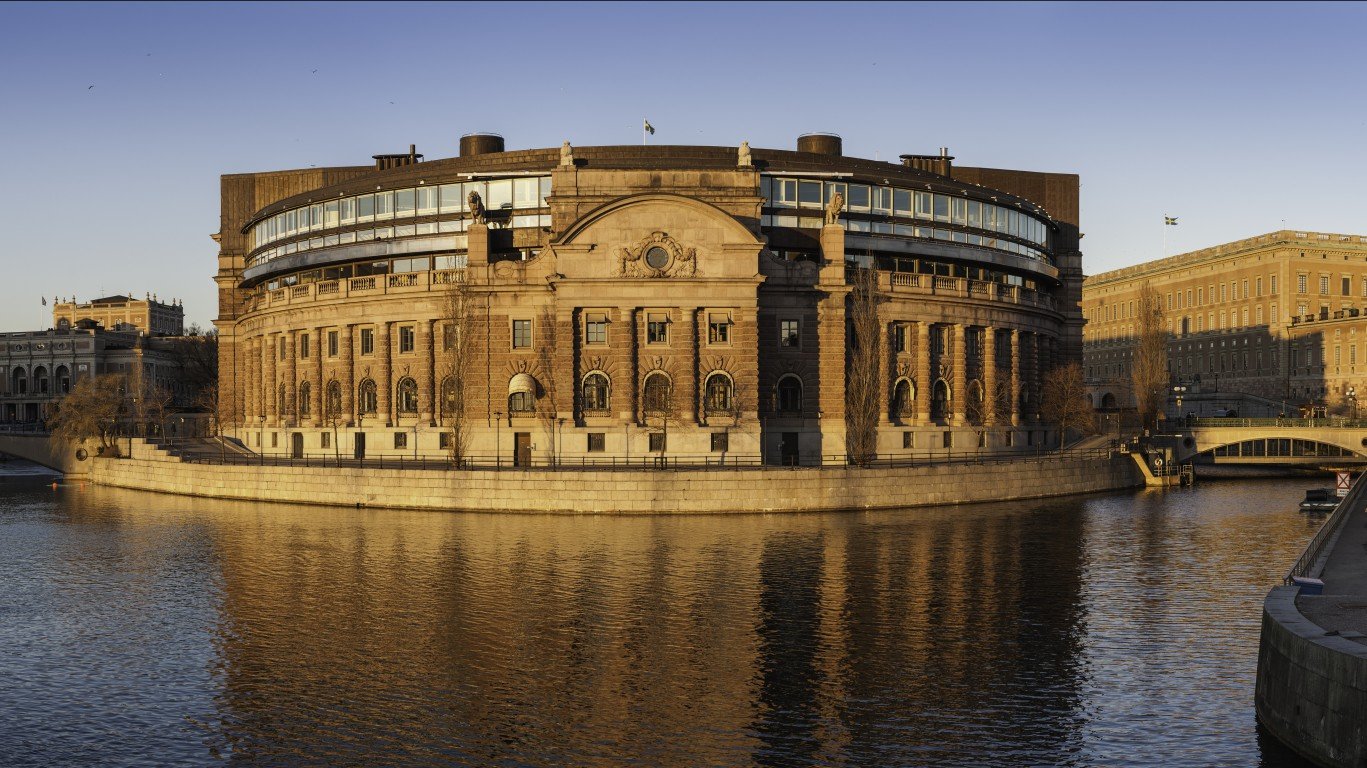
4. Sweden
> Overall index score: 71.3
> Vulnerability score: 0.30
> Best dimension: Human Habitat
> Readiness score: 0.72
> Best readiness dimension: Governance
> GDP per capita: $50,925 – #15 highest out of 182 countries
> Population: 10,353,442 – #86 highest out of 182 countries
Sweden will have warmer and wetter weather as the Earth warms. Precipitation has increased, especially in the summer, and is forecast to be 40% higher toward the end of this century compared to the latter half of last century. While some parts of the country will experience more drought conditions, the biggest risk of climate change to Sweden is from floods. In 2018, Sweden implemented a national plan to improve its climate resilience.

3. Switzerland
> Overall index score: 71.9
> Vulnerability score: 0.26
> Best dimension: Human Habitat
> Readiness score: 0.69
> Best readiness dimension: Governance
> GDP per capita: $68,755 – #5 highest out of 182 countries
> Population: 8,636,561 – #98 highest out of 182 countries
Switzerland’s average temperature is rising as much as three times faster than the global average, and winter precipitation is expected to increase significantly, manifesting as rain instead of snow and increasing the risk of cold-weather flooding. But like other small and affluent countries, Switzerland’s climate change challenges are among the most manageable in the world. The country has implemented an action plan to deal with rising energy demand and decreased hydroelectric power during the times of the year that are getting warmer and drier.

2. Finland
> Overall index score: 72.0
> Vulnerability score: 0.31
> Best dimension: Human Habitat
> Readiness score: 0.75
> Best readiness dimension: Governance
> GDP per capita: $47,397 – #18 highest out of 182 countries
> Population: 5,529,543 – #113 highest out of 182 countries
A fourth of Finland is situated in the Arctic Circle, and the country is highly susceptible to the effects of the world’s melting ice caps. Extreme weather events will increase the risk of floods along the country’s coastline. But rising temperatures will also have some advantageous effects in extreme northern climates by reducing demand for heating and increasing forest growth and crop yields. Finland was one of the first countries to adopt a national strategy to confront climate change challenges, in 2005.
[in-text-ad-2]

1. Norway
> Overall index score: 75.4
> Vulnerability score: 0.26
> Best dimension: Human Habitat
> Readiness score: 0.77
> Best readiness dimension: Governance
> GDP per capita: $63,548 – #6 highest out of 182 countries
> Population: 5,379,475 – #116 highest out of 182 countries
Norway will experience more summertime heatwaves, warmer winters, and heavier rainfalls due to global warming. Temperatures in the Arctic north of the country will increase faster then in the south, exacerbating flood risks. But this small and affluent Scandinavian country is one of the most equipped to confront the challenges of climate change, thanks in part to economic support from the country’s oil and gas sector, which accounts for 15% of Norway’s GDP and is a major contributor to the country’s sovereign wealth fund, one of the world’s largest.
Sponsored: Want to Retire Early? Here’s a Great First Step
Want retirement to come a few years earlier than you’d planned? Or are you ready to retire now, but want an extra set of eyes on your finances?
Now you can speak with up to 3 financial experts in your area for FREE. By simply clicking here you can begin to match with financial professionals who can help you build your plan to retire early. And the best part? The first conversation with them is free.
Click here to match with up to 3 financial pros who would be excited to help you make financial decisions.
Thank you for reading! Have some feedback for us?
Contact the 24/7 Wall St. editorial team.

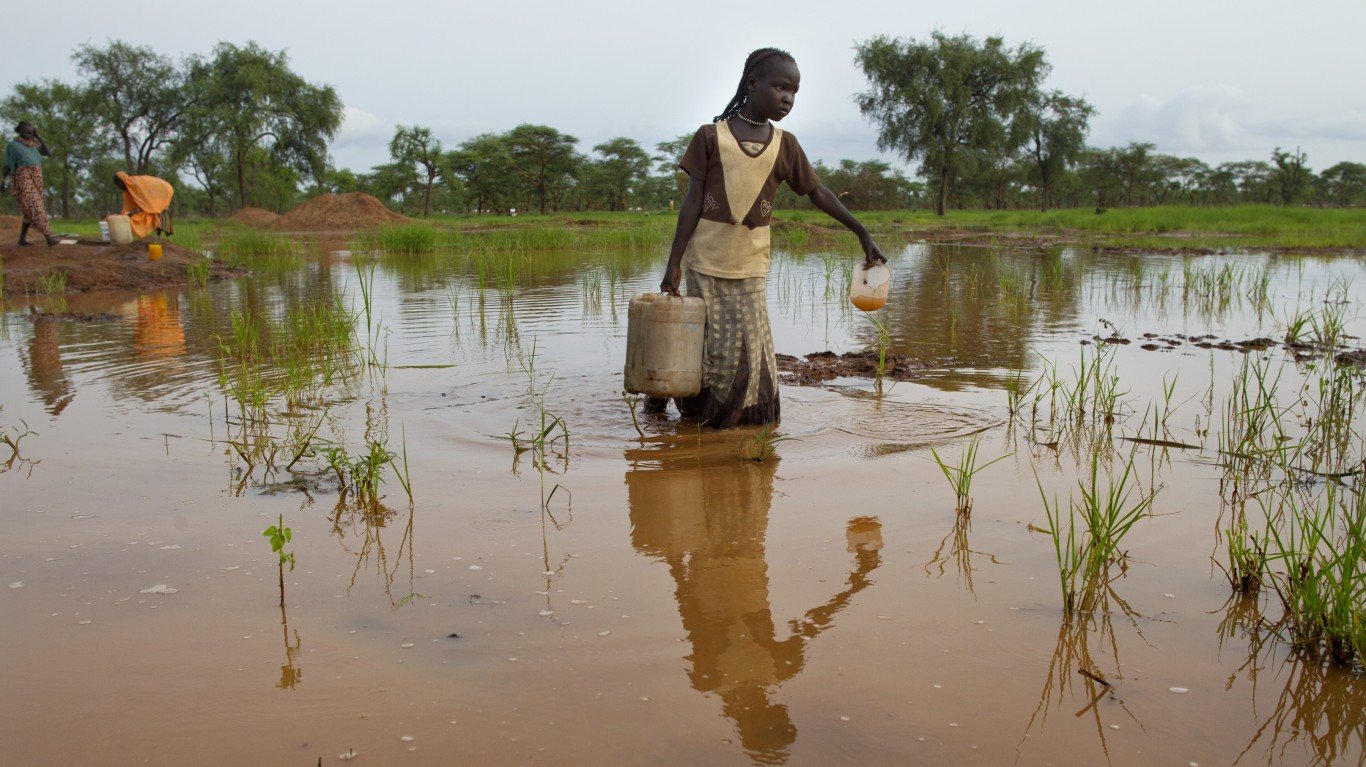 24/7 Wall St.
24/7 Wall St.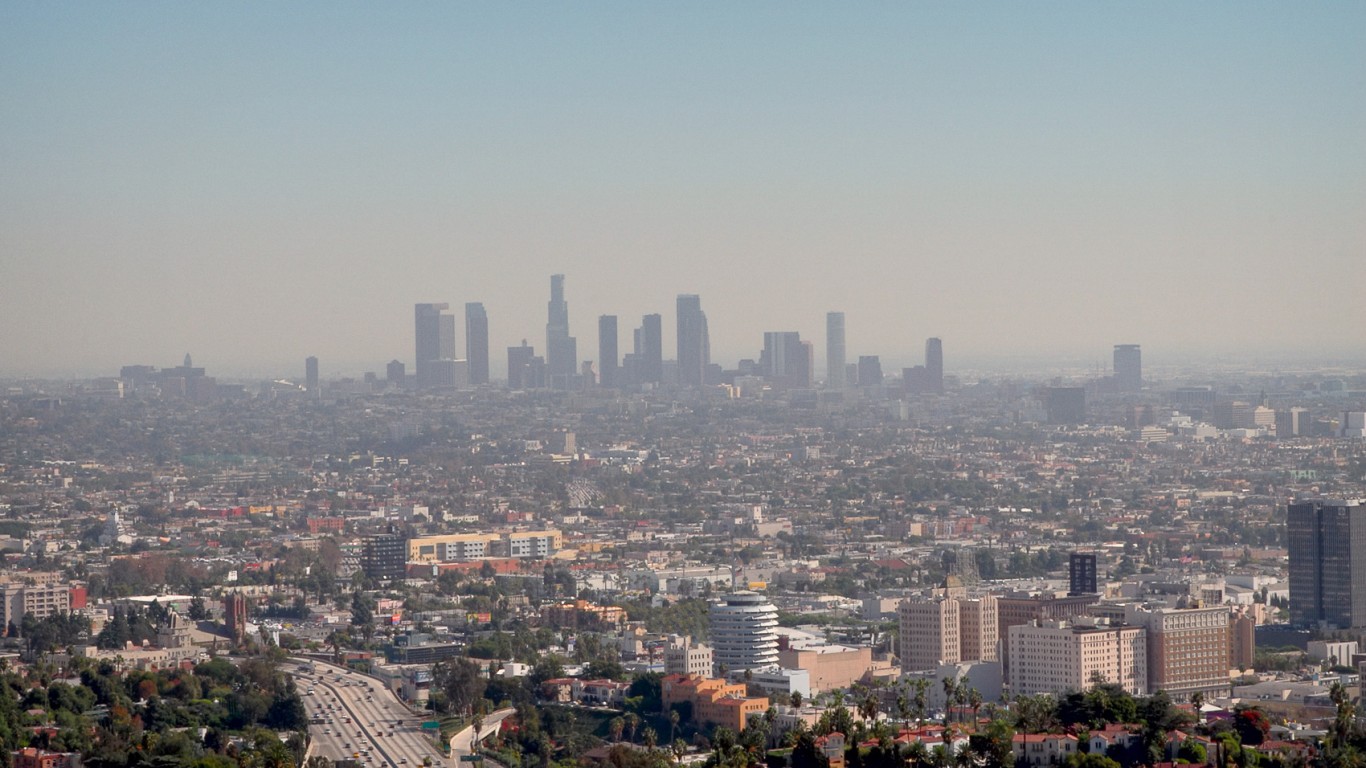 24/7 Wall St.
24/7 Wall St.